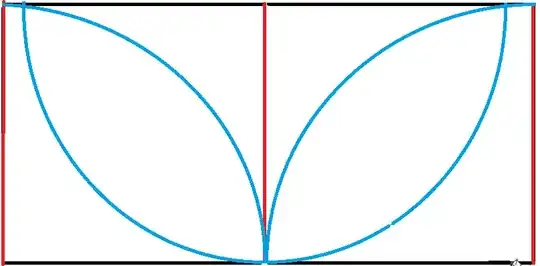Very interesting question indeed! So for now the goal is to prove your fourth diagram to be optimal. I am most likely not going to be able to prove this by myself, but I have some observations that I strongly believe to be useful in a proof. I also have some conceptual ideas to continue the proof and maybe even finish it, so my main goal is to inspire other people to continue or even finish the proof.
Proposition 1: Consider the area under a monotone increasing curve $f:[0,1]\to[0,\infty)$, so the set $$S:=\{(x,y):0\leq x\leq 1,0\leq y\leq f(x)\}.$$ Consider placing at most $n$ upper-semicircles with their centers on the $x$-axis. Then there is a configuration of largest area and one can be found by repeatedly placing the largest possible semicircle on the right.
Proof of Proposition 1: First note that the space of possible configurations can be modeled as a compact subset of $\mathbb{R}^{2n}$ by considering the centers and radii as parameters. Then the corresponding area is a continuous function, so it attains a maximum.
Consider a configuration of largest area. Number the semicircles $1$ to $n$ from right to left. Note that we can assume without loss of generality that the semicircles are then ordered from long to short. If not, we can simply keep swapping them until they are, because $f$ is monotone increasing.
Assume for the contrary there exists a semicircle that is not as large as possible. Let $i$ be minimal such that semicircle $i$ is not as large as possible. If $i=n$ we immediately get a contradiction. Let $r$ and $s$ be the radii of semicircles $i$ and $i+1$. We can increase $r$ and decrease $s$ by some $\varepsilon>0$. Because $r\geq s$ this gives a configuration of larger area, so again we have a contradiction. $\square$
Corollary 2: If infinitely many semicircles are allowed, there is still a configuration of largest area and one can be found by the same procedure.
Corollary 3: In the case $f(x)=hx$ the largest possible area with infinitely many semicircles is $$\frac{\pi h}{8\sqrt{h^2+1}}.$$ Actually finding this formula is just a lot of algebra, but feel free to verify.
The next logical step would be to consider the case where we have a right angled triangle and we can only place window wipers with their pivot on one of the legs and radius at most the distance to the hypotenuse. This becomes more difficult, not only because the window wipers on different legs influence each other, but also because not all wiping areas have to be semicircles anymore. From here on, let me just lay out some ideas to continue or even finish the proof.
First, let me note that I suspect this triangle case to be optimally solved by placing a quarter circle in the corner, but only if the width and height are within some margin of each other. For the general case, I suspect we want to split into two cases. With or without non-semicircular wiping areas.
First consider the case with non-semicircular wiping areas. Consider the largest non-semicircular wiping area. The rest of the triangle is then split into three regions. Two of them can be at least approximated by the case of Corollary 3 and the final region is again the case we are now trying to solve. Since we are only trying to show a specific configuration is optimal, my idea was to somehow bound the total area of the arbitrary configuration in question using these ideas.
Then for the case without non-semicircular wiping areas. I highly suspect this to never be optimal. For example, if we can place a quarter circle in the corner that does not cut any of the semicircles, then placing this instead of all the semicircles now inside it is obviously a large improvement. However I am having trouble generalizing this argument.
I want to finish off by noting that the conjectured optimal solution has an area of $$\frac{\pi}{2}\left(2-\sqrt{2}+8\sum_{n=1}^\infty\frac{1}{(\sqrt2+2n)^2(\sqrt2+2+2n)^2}\right)\approx0.9697926466...$$ in a unit square. More generally, the largest possible area in Proposition 1 for the function $f:[0,w]\to[0,\infty)$ given by $f(x)=1-\sqrt{1-x^2}$ is $$\frac{\pi}{8}\sum_{n=1}^\infty\frac{1}{\left(n+\frac1w-1\right)^2\left(n+\frac1w\right)^2}$$ if $0<w\leq1$ defines up to where you can place the semicircles.
EDIT: I have some more progress. Mainly the following proposition.
Proposition 4: Consider the area under a curve $f:[0,1]\to[0,\infty)$ with $f(0)=f(1)=0$, which is piecewise convex on $[0,a]$ and $[a,1]$ for some $0<a<1$. Consider placing infinitely many upper-semicircles with their centers on the $x$-axis. Then there is a configuration of largest area and one can be found by repeatedly placing the largest possible semicircle.
Idea of proof of Proposition 4: Like in Proposition 1, for any finite set of semicircles, we can rearrange them so they all touch. In this case, we find there is a largest semicircle, and going to the left or right we find the semicircles will decrease in size. Furthermore, we can assume all semicircles touch the curve $f$.
In the infinite case, we find all semicircles touch each other and the curve of $f$. It follows that the entire set is determined by any specific semicircle, or even any specific semicircle center. This gives a function $A:[0,1]\to[0,\infty)$ which, given any possible semicircle center, outputs the total area induced by that center.
Due to piecewise convexity, there is a unique possible semicircle touching both pieces of the curve of $f$. Let $...,c_{-1},c_0,c_1,...$ denote the induced centers of all the semicircles. We find $A(c_i)$ is independent of $i$. Furthermore, the piecewise convexity of $f$ can be used to show $A$ is convex in any interval $[c_i,c_{i+1}]$, as the sum of two convex functions. It follows that $A$ is maximal at the values $c_i$. $\square$
Remark: Note that $f$ does not need to be continuous at $a$.
We can use this proposition to analyze the following case.

So we have to fill a right angled triangle where all centers have to be on the legs. We consider the case where there is a non-semicircular sector (Purple) touching the hypotenuse. This splits the triangle into three regions: To the left of Purple, above Purple, and the Green triangle. By Proposition 4, it is optimal to place the Blue semicircle touching the hypotenuse and the Purple circular arc. Then all the orange semicircles both on the left of Purple and above Purple follow. The Green region is again a right angled triangle, which makes this problem recursive.
If we let $\varepsilon$ be the width of the Green triangle, we find the total area is a function of $\varepsilon$. Assuming the main triangle has base $1$ and height $h$, the area for $\varepsilon=0$ can be calculated as $$A_0(h)=\frac\pi{4}r^2+(1-r)^2f(h)+(h-r)^2f\left(\frac1h\right),$$ where $r=h/\sqrt{h^2+1}$ is the radius of the Purple circular arc, and $f(h)=(\pi/8)\cdot h/\sqrt{h^2+1}$ is the area found in Corollary 3. Note that the proportional area $A_0(h)/(h/2)\to\pi/4$ both as $h\to0$ and as $h\to\infty$. For $h\in(0,\infty)$, the proportion is larger, taking a maximum of $(3\sqrt2-2)\cdot(\pi/8)$ at $h=1$.
It can be argued for small values of $h$ that the difference between $A_0(h)$ and the optimal area is $O(h^2)$. So we know approximately how well the Green triangle can get filled. For $\varepsilon>0$ we find a total area of $$A_\varepsilon(h)=A_0(h)+\varepsilon\left[\left(\frac12+\frac\pi{8}\right)r+2h(h-r)f\left(\frac1h\right)-2A_0(h)\right]+O(\varepsilon^2).$$ Note that we still use $r=h/\sqrt{h^2+1}$ rather than the radius of the new Purple circular arc.
This gives the derivative of $\varepsilon\mapsto A_\varepsilon(h)$ at $\varepsilon=0$. With Wolfram Alpha, we find this derivative is negative in approximately the interval $h\in(0.5605,6.6187)$, and positive outside this interval. This proves that taking $\varepsilon=0$ is not always optimal, but it is also evidence that it is optimal for $h$ close to $1$.
Finally, the formula for the area in Proposition 1 for the curve $f:[0,w]\to[0,\infty)$, $f(x):=1-\sqrt{1-x^2}$ can be simplified, kind of, by $$\frac{\pi}{8}\sum_{n=1}^\infty\frac{1}{\left(n+\frac1w-1\right)^2\left(n+\frac1w\right)^2}=\frac\pi{8}\left[2\zeta\left(2,\frac1w\right)-w^2-2w\right],$$ with $\zeta(s,a):=\sum_{n=0}^\infty(n+a)^{-s}$ the Hurwitz zeta function. This makes the conjectured optimal area in a unit square equal to $$\frac\pi{2}\left(2\sqrt2-3+\zeta\left(2,1+\frac12\sqrt2\right)\right)\approx0.9697926466...$$ This should allow one to do an analysis similar to my analysis of the triangle, but with a circular sector as hypotenuse.






